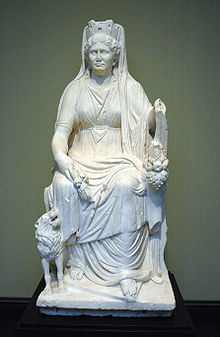
|

|

|

|
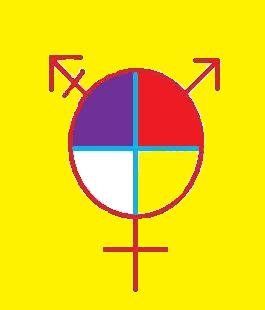
|
Joan Dark's Transsister Circle | 
|
|
Time-Line of Transgender History 2500 B.C.E.-2009 C.E. |
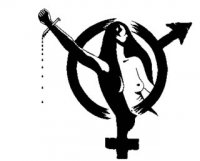
|
| Time | Place | Events | ||
| c. 2500 BCE (or earlier)1 - c. 300 CE | The Near East and Europe |
|
||
| 1479-1458 BCE | Egypt | Queen Hatsheput was the 18th Dynasty pharaoh of Egypt. She wore manly attire and wore the symbolic false beard as god and king of Egypt. In wall paintings she was pictured with short hair and usually with no female breasts. | ||
| 203 BCE | Rome | The Roman Senate made Cybele the official goddess of the Roman Republic. The first Gallae, transsexual priestesses of Cybele, arrived in Rome. | ||
| April 28, 1429 CE | France | 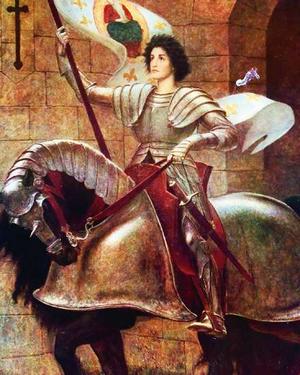 Jeanne d'Arc (right), known in English as Joan of Arc, in full battle armor, led a peasant army's march to the city of Orleans which was occupied by English forces. This was her first time in battle command. On the fate of Orleans hung that of the entire Kingdom of France.
Jeanne d'Arc (right), known in English as Joan of Arc, in full battle armor, led a peasant army's march to the city of Orleans which was occupied by English forces. This was her first time in battle command. On the fate of Orleans hung that of the entire Kingdom of France.
|
||
| April 29, 1429 | Orleans, France | Joan of Arc took Orleans in the name of the Prince Charles of France after the English retreated. (She routed the English Army by May 8.) | ||
| July 17, 1429 | Reims, France | As a result of Joan's many military successes against the English and their Burgundian allies, Prince Philip is crowned King of France at Reims. Joan stood at his side, holding her combat banner, as he was crowned. The nation of France was born. | ||
| May 23, 1430 | Compeigne, France | Joan of Arc was captured by the Burgundians who soon sold her to the English. (The English later held her for ransom, but the French nobility refused to pay the cost.) | ||
| May 30, 1431 | Rouen, France | Joan of Arc was burned at the stake after being brought to trial by the English on charges of heresy and witchcraft. Even though the court was rigged against her, she was found not guilty as originally charged. The technical reason for her execution was that she wore men's clothes and refused to stop. This was regarded as an offense against God.3 | ||
| 1513 | Panama | The Spanish Chronicler Peter Martyr accompanied the famous conquistador Vasco Nunez de Balboa on his expedition through Panama. He wrote of Balboa's encounter with the Native American Querequas in 1513: "Vasco discovered that the village of Quarequa was stained by the foulest vice. The king's brothers and a number of other courtiers were dressed as women, and according to the accounts of the neighbors shared the same passion. Vasco ordered forty of them to be torn to pieces by dogs."4 | ||
| 1576 | Northeastern Brazil | Pedro de Maghalhaes wrote about females among the Native American Tupinamba who lived as men, hunted, and went to war. They were accepted as men by the other men in their tribe. They reminded Maghalhaes and his team of Portuguese explorers of the all-female Amazon warriors in Greek mythology. Accordingly, they renamed the river that flowed through that area the River of the Amazons.5 | ||
| Early 1600's | Spain and Spanish America | Catalino d'Erauso (1592-1650) had been born in the city of San Sebastian in the Basque region of Spain. She had been sent to a convent at the age of 4. She left the convent at the age of 15 after being beaten. She dresses as a man, calling herself Francisco de Loyola. She eventually signed up on a ship which took her to South America. She then enlisted as a soldier under the name Alonso Diaz Ramirez de Guzman. She served successfully under several captains. She eventually told the truth about herself to a bishop and entered a convent. Her story spread back to Europe. In 1624 she arrived in Spain. Later, she traveled through Italy and obtained a dispensation from Pope Urban VIII to wear men's clothes. In 1645 she went to New Spain (Mexico) and became a mule driver under the name of Antonio de Erauso. She died in New Spain in 1650.6 | ||
| 1673 | Along the northern half of the Mississippi River | The French Jesuit missionary-explorer Jacques Marquette described the attitudes of the Illini and Nadouessi tribes to men who lived as women and women who lived as men: "They are summoned to the Councils, and nothing can be decided wthout their advice. Finally, through their profession of leading an Extraordinary life, they pass for Manitous,-that is to say, for Spirits,-or persons of consequence."7 | ||
| October 1720 | Near the west coast of Jamaica |
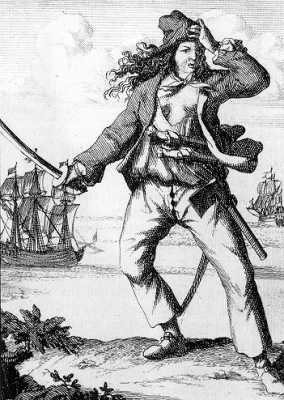 In October 1720, the pirate captain John "Calico Jack" Rackham, his pirate lover Anne Bonny, and their pirate companion Mary Read (right) were captured in Rockham's ship off the west coast of Jamaica by pirate hunter Jonathan Barnett and his crew. Mary Read had dressed as a man and passed herself as a man most of the time since her childhood after her brother had died. Mary had pretended that she was her brother after his death so that she and her widowed mother could continue to receive money from Mary's paternal grandmother. Before meeting Rockham and Anne Bonny, Mary Read at different times had been a soldier, an ordinary seaman, and a pirate. She continued with her pirate life after joining up with Rockham. Both Mary and Rocham's lover Anne Bonny fought as pirates while dressed as men.
After the capture of Rochham, Anne Bonny, and Mary Read in October 1720, all three were tried and found guilty of piracy. Rockham was hanged. But both Anne and Mary were given temporary stays of execution on the grounds that they were pregnant. Mary Read died from illness or childbirth while still in jail. But Anne Bonny was ransomed by her father and was married before the end of the year. She then lived a respectable life until she died at the age of 81 years old.8
In October 1720, the pirate captain John "Calico Jack" Rackham, his pirate lover Anne Bonny, and their pirate companion Mary Read (right) were captured in Rockham's ship off the west coast of Jamaica by pirate hunter Jonathan Barnett and his crew. Mary Read had dressed as a man and passed herself as a man most of the time since her childhood after her brother had died. Mary had pretended that she was her brother after his death so that she and her widowed mother could continue to receive money from Mary's paternal grandmother. Before meeting Rockham and Anne Bonny, Mary Read at different times had been a soldier, an ordinary seaman, and a pirate. She continued with her pirate life after joining up with Rockham. Both Mary and Rocham's lover Anne Bonny fought as pirates while dressed as men.
After the capture of Rochham, Anne Bonny, and Mary Read in October 1720, all three were tried and found guilty of piracy. Rockham was hanged. But both Anne and Mary were given temporary stays of execution on the grounds that they were pregnant. Mary Read died from illness or childbirth while still in jail. But Anne Bonny was ransomed by her father and was married before the end of the year. She then lived a respectable life until she died at the age of 81 years old.8
|
||
| 1724 | Western Great Lakes region, Florida, and Louisiana | French missionary Joseph Francois Lafitau deplored men living as women and women living as men, but he wrote that, among the Native Americans he found in the Western Great Lakes region, Florida, and Louisiana, "They believe they are honored. They participate in all religious ceremonies, and this profession of an extraordinary life causes them to be regarded as people of a higher order..."9 | ||
| 1843 | Salisbury, Conneticut | Levi Sudyam, a 24-year old resident of the town, asked the town selectmen to validate his right to vote as a Whig in the current town election. Local Tories protested that he was too much of a woman. Women were not allowed to vote. The local doctor reached into Sudyam's pants and found male genatalia. Sudyam was allowed to vote. The Whigs won the election by one vote. Days later, the doctor gave Sudyam a thorough physical examination. He found that Sudyam also had a vaginal opening and menstruated. It is not known how the dispute over the election was finally settled, or what was the result.10 | ||
| Late 1890's | Montana | During the late 1890's, one government agent incarcerated the male-to-female bades [singular: bade, pronounced as bah-day] on one Crow reservation, cut off their hair, and forced them to do manual labor for the Bureau of Indian Affairs (BIA).11 | ||
| 1897 | Germany |
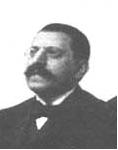 Dr. Magnus Hirschfeld (1868-1935) (right) founded the Scientific Humanitarian Committee. Its goal was the repeal of German laws criminalizing homosexuality. Its petition was signed by over 5000 prominent Germans.12
Dr. Magnus Hirschfeld (1868-1935) (right) founded the Scientific Humanitarian Committee. Its goal was the repeal of German laws criminalizing homosexuality. Its petition was signed by over 5000 prominent Germans.12
|
||
| 1910 | Germany | Magnus Hirschfeld published his work Transvestites. He himself coined the word transvestite. He applied the word in a wider sense than it is generally used today. His meaning for the word covered virtually all transgendered people, including transsexuals, who feel motivated to cross-dress. In his publication, Hirschfeld made the distinction between homosexuals and "transvestites." This was the first time in the world that such a distinction had been made in a published work.13 | ||
| 1915 | England | In the bio-medical context, the word gender first appeared in the literature on human "hermaphroditism" and was used by William Blair Bell (1915), a Liverpool surgeon who contributed to a shift in the medical and scientific definition of what was then called hermaphroditism (now called intersex), and thus also to a shift in what was considered the "true sex" of an individual. This was tied in with the then recent development of medical technologies that could correctly identify gonad tissue and distinguish between ovarian cells and testicular cells, and which provided surgical options for removing sexual organs.14 | ||
| 1918 | New York | Earl Lind, a resident of New York and a self-described "androgyne", "hermaphrodite", and "fairy" who also went by the name Jennie June, had her first autobiographical work, "Autobiography of an Androgyne" published. This was written mainly for doctors to read and intended to "help the suffering androgyne." (See below: 1922 New York.)15 | ||
| 1918 | Portland (?), Oregon | Alan Lucill (Alberta Lucille) Hart (1890-1962) became the first FTM transsexual to have a radical hysterectomy in order to live his life fully as a man. Shortly afterwards, he changed his name from Alberta Lucille Hart to Alan Lucil Hart, and married Inaz Stark who was well aware that he had born with a female body. He then entered the medical profession as a fully male radiologist. The year before his surgery, Hart had graduated with honors from the University of Oregon Medical School. That year also, he had begun seeing the American psychiatrist Dr. Joshua Gilbert. Gilbert came to the conclusion that Hart was psychologically a mentally healthy man though he had a woman's body. Gilbhert came to agree with Hart that Hart needed the surgery to be able to live a happy life.16 | ||
| 1919 | Institute for Sexual Research, Berlin, Germany | Magnus Hirschfeld established his Institute for Sexual Research. The institute did pioneering work regarding sexual reassignment surgery, among other areas of research.17 | ||
| c. 1920-c. 1940 | South Dakota | During the 1920's and 1930's, government agents and Christian missionaries put pressure on the winktes of the Lakota Sioux living on reservations to change their ways, saying they were no good. Some did, and dressed in men's clothing. Others hanged themselves rather than change. [A winkte (prounced as wink-tay) was a male-to-female member of the Lakota nation who once had an important role in the spiritual life of his people.]18 | ||
| 1922 | New York City | Earl Lind (a.k.a. Jennie June) published her second autobiographical work intended to "help the suffering androgyne." This book was titled "The Female Impersonators." Its intended audience is the general public.19 (See above: 1918 New York.) | ||
| 1923 | Berlin, Germany | Magnus Hirschfeld used the term seelischen Transsexualismus (spiritual transsexualism), but he applied it to a form of "inversion" (homosexuality). He still used the term transvestite for people who wanted to physically change their sex, as well as for other cross-dressers.20 (David Cauldwell was the first to use the term transsexual to mean a person seeking to be a member of the opposite sex through surgery. See "1949 United States" below.) | ||
| 1931 | Institute for Sexual Research, Berlin, Germany | Dorchen Richter had her penis removed and a vagina surgically reconstructed. She had already had her testicles removed (orchiectomy) in 1922. Her's was the first documented case of male-to-female genital transformation surgery.21 | ||
| May 6, 1933 | Institute for Sexual Research, Berlin, Germany | The Nazis attacked Magnus Hirschfeld's Insitute for Sexual Research and burned its files and most of its books. That ended the Institute. Fortunately, Hirschfeld was out of Germany, on a lecture tour, at the time. He never returned to Germany. He became a resident of Nice, France after living in Paris for a while. He died in 1935.22 | ||
| 1942 | England |
 Laurence Michael Dillon (1915-1962) (right), a.k.a. Michael Dillon, had a mastectomy after having taken testosterone pills for some time. He changed his name on his birth certificate from Laura Maud Dillon two years later (1944). He was the first FTM transsexual in England to take male hormones and have a mastectomy. He died in India in 1962 after having been ordained a Tibetan Buddhist monk.23
Laurence Michael Dillon (1915-1962) (right), a.k.a. Michael Dillon, had a mastectomy after having taken testosterone pills for some time. He changed his name on his birth certificate from Laura Maud Dillon two years later (1944). He was the first FTM transsexual in England to take male hormones and have a mastectomy. He died in India in 1962 after having been ordained a Tibetan Buddhist monk.23
|
||
| 1947 | Indiana University, Bloomington, Indiana | Alfred Charles Kinsey (1894-1956), an American biologist and professor of entomology and zoology, founded the Institute for Research in Sex, Gender and Reproduction at Indiana University, now called the Kinsey Institute for Research in Sex, Gender, and Reproduction.24 | ||
| 1948 | United States | Alfred C. Kinsey, Charles Ward, and Clyde E. Martin published their first book based on their research, Sexual Behavior in the Human Male. This is frequently referred to as the "first Kinsey Report." The book is mostly based on private, systematic interviews of many individuals and statistical analysis of the findings. The second Kinsey Report, Sexual Behavior in the Human Female by the same authors, was published in 1952.25 | ||
| 1949 | United States | Psychiatrist Dr. David O. Cauldwell used the term transsexual to refer to people who wished to be members of the sex opposite to them and wished to use surgery to alter their appearance so that they would appear to be such.26 (The only recognized use of the term prior to this was that of Hirschfeld in 1923. See "1923, Germany" above.) | ||
| August, 1950 | Statens Seruminstitut, Copenhagen, Denmark |
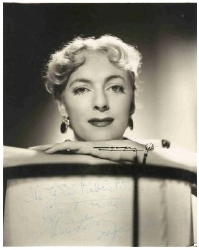 American MTF transsexual Christine Jorgensen (right), known then as George Jorgensen and still resembling a man, began taking estrogen under the supervision of Dr. Christian Hamburger.27
American MTF transsexual Christine Jorgensen (right), known then as George Jorgensen and still resembling a man, began taking estrogen under the supervision of Dr. Christian Hamburger.27
|
||
| September 24, 1951 | Gentofte Hospital, Copenhagen, Denmark | Christine Jorgensen underwent her orchiectomy.28 | ||
| November 22, 1952 | Rigs Hospital, Copenhagen, Denmark | Christine Jorgensen underwent her penectomy.29 | ||
| December 1, 1952 | New York City | The New York Times broke the news of Christine Jorgensen's sexual transformation. The front page headline: "EX-GI BECOMES BLONDE BEAUTY"-"Operations Transform Bronx Youth." The story was soon reprinted on the front pages of newspapers around the world.30 | ||
| 1953 | Los Angeles, California | Tamara Rees (1924- ) began taking estrogen and living as a woman.31 | ||
| December 18, 1953 | New York Academy of Medicine | Dr. Harry Benjamin used the term transsexualism in a medical context. This occurred in a lecture he gave at the Academy. It was the term had been used in this way, if not the first use of the term in any context.32 | ||
| 1954 | Holland | Tamara Rees underwent genital surgery. Upon returning to the United States, she was greeted with as much fanfare as Christine Jorgensen. Unlike Jorgensen, she welcomed the publicity. Shortly after returning to Los Angeles, she became a burlesque queen.33 | ||
| Late May, 1954 | A small hospital in New Jersey | Christine Jorgensen underwent her final genital surgery. Her labia and vaginal canal were constructed from tissue taken from her upper thigh. But the change was mainly a cosmetic one - they did not give her the ability to enjoy having sex.34 | ||
| 1955 | Reno, Nevada | Tamara Rees married James E. Courtland III.35 | ||
| 1955 | Johns Hopkins University, Baltimore, Maryland |
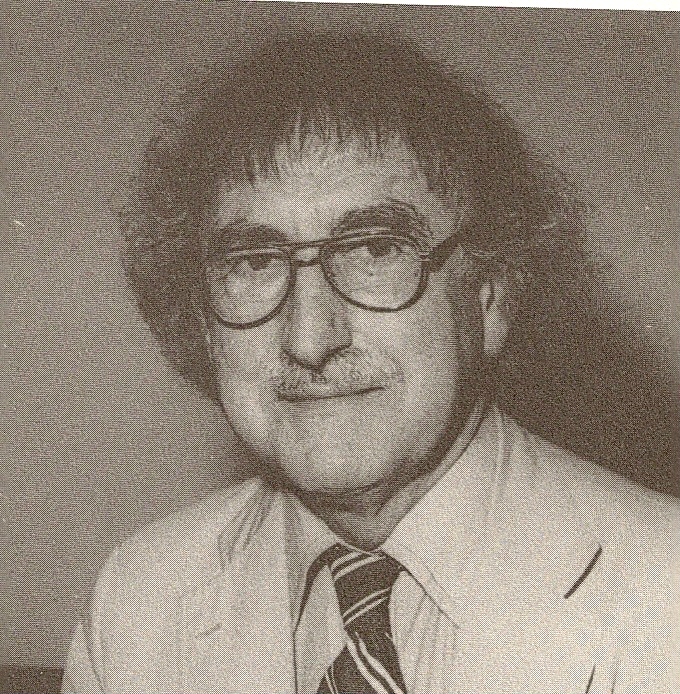 John Money (right), a psychologist at Johns Hopkins University, used the term gender role to refer to "all things that a person says or does to disclose himself or herself as having the status of boy or man, girl or woman." He used the single word single word gender to refer to refer to "outlook, demeanor, and orientation." John Money with Joan G. Hampson and John L. Hampson later coauthored articles that used the term "gender role and orientation." Thus, at this time, Money considered gender to be a psychosocial construction.36
John Money (right), a psychologist at Johns Hopkins University, used the term gender role to refer to "all things that a person says or does to disclose himself or herself as having the status of boy or man, girl or woman." He used the single word single word gender to refer to refer to "outlook, demeanor, and orientation." John Money with Joan G. Hampson and John L. Hampson later coauthored articles that used the term "gender role and orientation." Thus, at this time, Money considered gender to be a psychosocial construction.36
|
||
| 1956 | Casablanca, Morocco | Dr. Georges Burou's invented his technique for male-to-female sex reassignment surgery (vaginoplasty) in which the vagina is constructed from tissue from the patient's penis. Essentially, tissue forming the sheath of the penis is "inverted" (turned inside-out) to form the vagina. This vagina is then insertrd into a cavity that has been surgically formed. Later, hundreds of surgeons around the world "reverse-engineered" the technique after examining patients that had received the surgery.37 | ||
| May 1959 | Los Angeles | Drag queens and gays clashed with LAPD police at Cooper's Donuts. The police had been frequently harassing them. When three people were arrested, including novelist John Rechy, other people began pelting the police with coffee cups and donuts. John Rechy and the other two arrested got away, but others were arrested.38 | ||
| 1962 | San Francisco, California | Police sergeant Elliott Blackstone was designated as the San Francisco Police Department's first liaison officer with the "homophile community," as it was then called. Blackstone worked within the police department to change policy and procedures directed against the gay, lesbian, and transgender community, such as entrapment of gay men in public restrooms. Over the following years, he worked closely with local LGBT activist groups such as Mattachine, Daughters of Bilitis, the Vanguard gay youth group, the National Transsexual Counseling Unit, and the Council on Religion and the Homosexual. Blackstone even took up a collection at his church to buy hormones for transgender people, at a time when city-funded health clinics would not provide hormones to them.39 | ||
| 1963 | United States | Reed Erickson, a multi-millionaire and the first female graduate of Louisiana State University's Mechanical Engineering program, contacted Harry Benjamin and began to masculinize his body, and live as a man.40 | ||
| 1964 | New York City | Reed Erickson founded the Erickson Educational Foundation (EEF) that supported his many interests including research and education on transsexuality. Later this same year, the Erickson Educational Foundation enabled Harry Benjamin to organize his friends into the Harry Benjamin Foundation.41 | ||
| 1964 | University of California at Los Angeles (UCLA) | UCLA psychiatrist/psychoanalyst Robert J. Stoller, with his colleague Ralph Greenson, coined the term "gender identity," using it to mean what previously had been termed "psychological sex." He distinguished it from "sexual identity," limiting the latter to male/female identity when it is taken on by a person only in the context of sexual fantasy, sexual role playing, etc. The distinction he made between the terms "gender identity" and "gender role" made more clear the difference between the inner, subjective sense of oneself being male (or female) and the external presentation of being masculine (or feminine).42 | ||
| 1964 | St. Louis, Missouri | William Masters and Virginia E. Johnson founded the the Reproductive Biology Research Foundation, renamed the Masters and Johnson Institute in 1978.43 | ||
| September 19, 1964 | Whitehall Street Induction Center, New York City | A small group led by activist Randy Wicker picketed the Whitehall Street Induction Center after the confidentiality of gay men was violated by the draft board. This was the first civil protest in the United States on behalf of gay rights.44 | ||
| December 2, 1964 | New York City | Four gay men and lesbians picketed picketed a lecture by a psychoanalyst espousing his conceptions of homosexuality as a form of mental illness. The picketers were allowed ten minutes to give a rebuttal.45 | ||
| 1966 | United States |
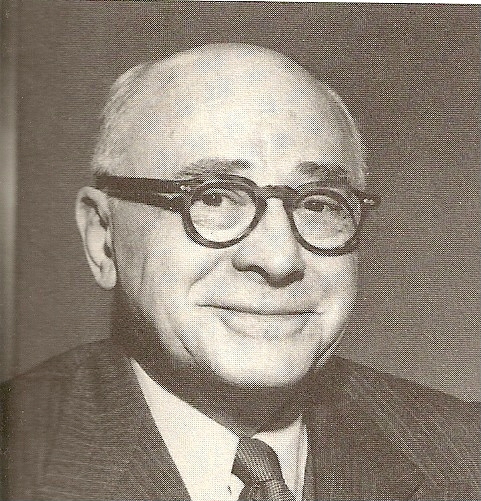
Dr. Harry Benjamin (right) published his groundbreaking book, The Transsexual Phenomenon.46 |
||
| 1966 | United States | William Masters and Virginia E. Johnson publish their first book, Human Sexual Response. The book is based on their own research involving direct laboratory observations.47 | ||
| August 1966 | Compton's Cafeteria, corner of Turk and Taylor streets, the "Tenderloin" district, San Francisco, California. |
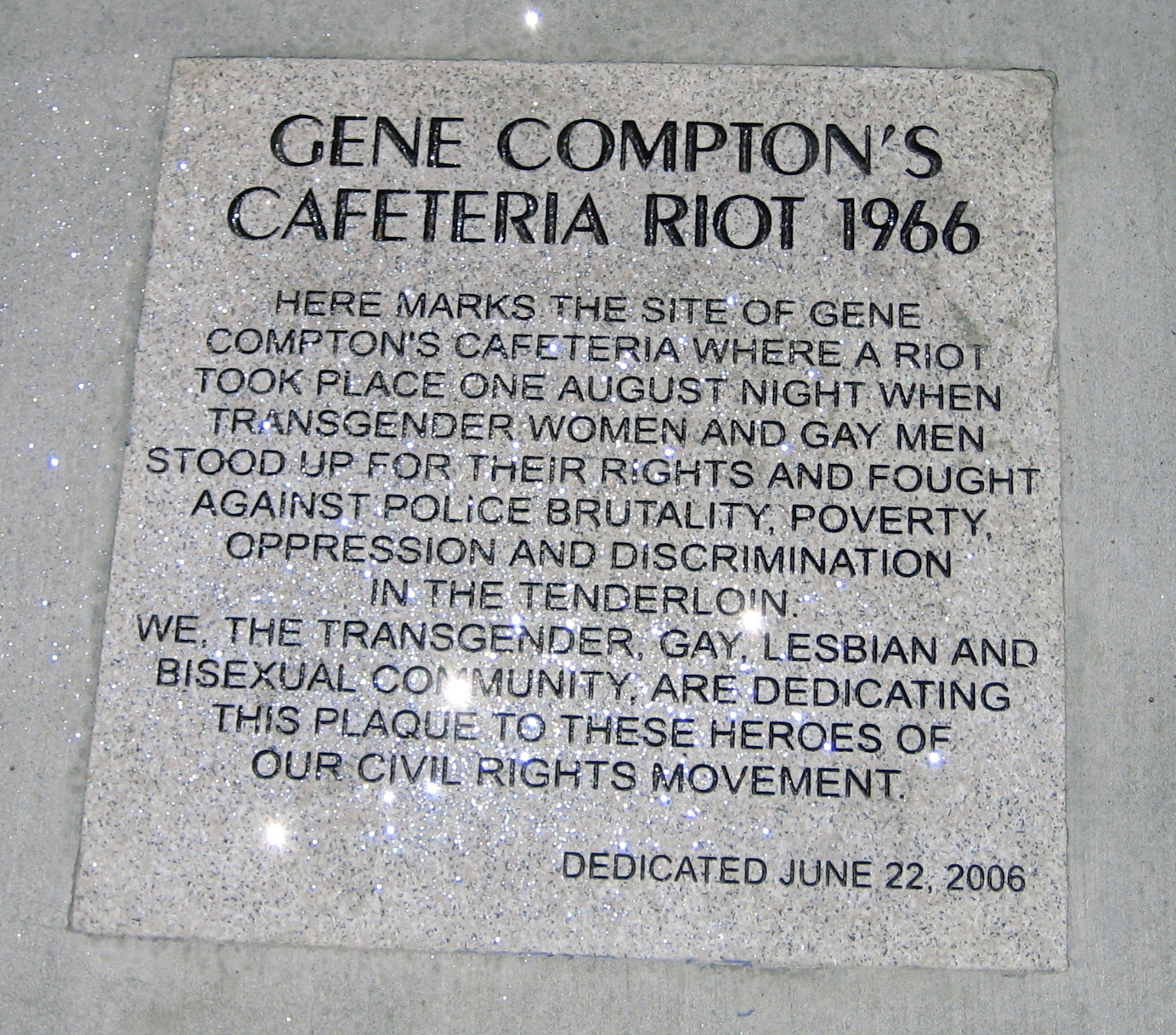 The Compton's Cafeteria Riot occurred on a weekend night in August 1966. The exact date is unknown. That night the cafeteria was packed with its usual crowd of drag queens, hustlers, run-away teenagers, and Tenderloin street people. One group of drag-queens was occupying a table for too long without spending enough money. The management called the police to have these drag-queens expelled. It was illegal in San Francisco for a man to dress in women's clothing. When the policemen came, one police officer grabbed one of the queens by the arm and tried to drag her out into the street. The queen threw her coffee in his face. This triggered Compton's customers - about fifty to sixty them- to begin throwing plates, trays, cups, and silverware at the police. The customers next turned the tables over and and smashed the plate glass doors. They then ran out into the street.
The queens and beat the police with their heavy purses and kicked them with their high-heel shoes. They and their allies vandalized a police car, burned a newspaper stand down to the ground, and raised general havoc in the Tenderloin that night. The riot was not reported in the newspapers. Which is one reason why the exact date is unknown.48
The Compton's Cafeteria Riot occurred on a weekend night in August 1966. The exact date is unknown. That night the cafeteria was packed with its usual crowd of drag queens, hustlers, run-away teenagers, and Tenderloin street people. One group of drag-queens was occupying a table for too long without spending enough money. The management called the police to have these drag-queens expelled. It was illegal in San Francisco for a man to dress in women's clothing. When the policemen came, one police officer grabbed one of the queens by the arm and tried to drag her out into the street. The queen threw her coffee in his face. This triggered Compton's customers - about fifty to sixty them- to begin throwing plates, trays, cups, and silverware at the police. The customers next turned the tables over and and smashed the plate glass doors. They then ran out into the street.
The queens and beat the police with their heavy purses and kicked them with their high-heel shoes. They and their allies vandalized a police car, burned a newspaper stand down to the ground, and raised general havoc in the Tenderloin that night. The riot was not reported in the newspapers. Which is one reason why the exact date is unknown.48
|
||
| Fall, 1966 | San Francisco, California | The Central City Anti-Poverty Program Office opened that fall as the result of the Tenderloin organizing campaign that had sprung up in the wake of the Compton's Cafeteria Riot in August. This multi-service agency included an office for SFPD Sergeant Elliott Blackstone, the police community-relations laison officer to "homophile" community since 1962. (See "1962 San Francisco" above.) A transgender neighborhood resident, Louise Ergestrasse came into Blackstone's office, dropped a copy of Harry Benjamin's book The Transsexual Phenomenon on Blackstone's desk, and demanded that he do something for "her people." Blackstone soon became educated in the matter and he took a leading role in changing police treatment of transgender people.49 | ||
| Fall 1966 | San Francisco | Another group of transgender Tenderloin activists, led by a MTF transsexual patient of Harry Benjamin named Wendy Kohler, began working with activist doctor Joel Fort at the Center for Special Problems, a unit of the San Francisco Public Health Department.50 | ||
| November, 1966 | Johns Hopkins University, Baltimore, Maryland | Johns Hopkins University inaugurated its Johns Hopkins University Gender Institute Clinic (later renamed The Johns Hopkins Identity Clinic). It was the first university medical center to recognize, endorse, and conduct sex reassignment surgery. This gave legitimacy to such surgery in the United States. John Money was a key figure in establishing the clinic. (See also 1955 Johns Hopkins University above.) The university had already been studying and treating intersex conditions.51 | ||
| 1967 | San Francisco, California | A group of transsexuals in San Francisco formed COG, meaning either "Conversion Our Goal" or "Change: Our Goal"--accounts differ on this question. According to one account, it was "probably the first formal organization of self-defined transsexuals in the world." It attracted white, low income, pre-operative transsexuals, most of whom lived in the tenderloin and worked as prostitutes. About a year after its founding, COG had seventeen members, all of whom but one were male-to-female. The one exception was female-to-male. COG offered mutual support among its members. Other than that, it had ambitious political goals. It called for freedom from police harassment, legal rights to change sex, fair housing laws, equal employment oppurtunities, and the abolition of discrimination in stores, restaurants, and other places of business. They also sought inexpensive surgery at the Johns Hopkins Gender Institute Clinic. COG held its regular meetings twice each month at Glide Church. COG also met with police and made public educational presentations.52 | ||
| 1967 | United States | Christine Jorgensen published her autobiography, Christine Jorgensen: A Personal Autobiography.53 | ||
| 1968 | New York City | Reed Erickson and his Erickson Educational Foundation cut off all funding to Harry Benjamin and the Harry Benjamin Foundation. The latter organization collapsed.54 | ||
| 1968 | Stanford University, Palo Alto, California | The Stanford University Gender Reorientation Program, later renamed the Gender Identity Clinic, was established.55 | ||
| 1968 | New York City | Civil Court Judge Francis N. Pecora accepted the application of a post-op MTF transsexual, an exotic dancer whose stage name was "Naughty Lola", to change her legal name from Robert to Risa. The judge wrote up his decision. In this document, he writes that "a male transsexual who submits to sex-reassignment is anatomically and psychologically a female in fact."56 | ||
| 1968 | United States | Mario Martino, a FTM transsexual, founded Labyrinth Foundation Counseling Service, the first organization in the United States devoted entirely to the needs of transsexual men. It was not a political organization. Martino and his wife, both professional healthcare workers, helped FTM transsexuals find appropriate steps and stations within the labyrinth of transgendered medical services that had begun to emerge.57 | ||
| 1968 | United States | In Sex and Gender: On the Development of Masculinity and Femininity (Science House, 1968), Robert J. Stoller articulates a challenge to Freud's belief in biological bisexuality. Drawing on his extensive research with transsexuals and new advances in the science of sex, Stoller advances his belief in "Primary Femininity," the initial orientation of both biological tissue and psychological identification toward feminine development. This early, non-conflictual phase contributes to a feminine core gender identity in both boys and girls unless a masculine force is present to interrupt the symbiotic relationship with the mother. (Stoller initially supported the idea that gender was determined by a drive whose origin was completely biological. a biological force, drive determining gender. By 1968, he had moved to a semi-psychological explanation. He summed up the origins what we now call male-to-female transsexuality in the formula: "dominant mother, father pushed to the side, infant cuddly and lovable, mother-son too close." For female-to-male transsexuals, Stoller's expanations can be reduced to "too much father and too little mother masculinizes girls.")58 | ||
| April 23, 1968 | Columbia University, New York City | The Student Homophile League of Columbia University protested the classification of homosexuality as a mental illness by picketing and disrupting a panel of psychiatrists discussing homosexuality.59 | ||
| 1969 | United States | The anthology Transsexualism and Sex Reassignment was published. It is edited by Richard Green and John Money. The foreword is written by Reed Erickson. The introduction is by Harry Benjamin. Over half of the thirty-two articles it contains were written by researchers affiliated with the UCLA Gender Identity Research Clinic, the Harry Benjamin Foundation, and the Johns Hopkins Identity Clinic. It was used as a handbook by doctors who treated transsexual patients. It provided detailed outlines of treatments using hormones or surgery.60 | ||
| 1969 | New York City | Following the collapse of the Harry Benjamin Foundation the year before, Harry Benjamin reorganizes his research as the Harry Benjamin Research Project with funding from "personal friends."61 | ||
| 1969 | San Francisco | COG (formed in 1967 San Francisco) by this time had mostly fallen apart, due to a lack of funds combined with the transience of its members. But Zelda Suplee of the Erickson Educational Foundation (EEF, found by Reed Erickson in 1964) had discovered COG and one of its small splinter groups, CATS. The EEF decided to support their initiative. They hired COG member Wendy Kohler (who had worked with activist doctor Joel Fort at the Center for Special Problems Fall, beginning in Fall 1966, and later joined COG) to work as a research coordinator with police sergeant Elliot Blackstone (see San Francisco Fall 1966). With EEF funding, Kohler opened a storefront office in the same building in the Tenderloin that housed two gay organizations, the Mattachine Society and the Daughters of Bilitis. Kohler became the first director of the National Gender-Sexual Identification Council (NGSIC) funded by the EEF. The NGSIC soon became the National Transsexual Counseling Unit (NTCU).62 | ||
| June 28, 1969 (Early AM) | Greenwhich Village, New York City |
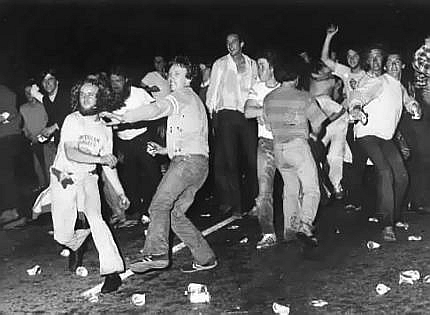 The Stone Wall Riot began. It was triggered by a police raid of the Stonewall Wall Inn, a gay bar--though it was by no means the first time that a Greenwhich Village gay bar had been raided. The initial riot lasted for a number of hours. The next night, thousands of people gathered at the Inn to protest. Police arrived to break up the crowd. The scene turned more violent than the early morning riot had been. Protest rallies and minor confrontations continued over the next few days. The general event is considered to be the starting point of gay liberation.63
The Stone Wall Riot began. It was triggered by a police raid of the Stonewall Wall Inn, a gay bar--though it was by no means the first time that a Greenwhich Village gay bar had been raided. The initial riot lasted for a number of hours. The next night, thousands of people gathered at the Inn to protest. Police arrived to break up the crowd. The scene turned more violent than the early morning riot had been. Protest rallies and minor confrontations continued over the next few days. The general event is considered to be the starting point of gay liberation.63
|
||
| 1970 | New York City | Silvia Rivera and Marsha P. Johnson, both veterans of the Stonewall Riot, established STAR--Street Transvestite Action Revolutionaries. Their primary goal was to help transgendered kids on the street find food, clothing, and a place to live. They hoped to ultimately establish a school for kids who'd never learned to read or write. They opened STAR House where dozens of transgendered young people could sleep safely without charge. STAR House lasted for two or three years. It inspired the establishment of a few similar houses in other cities, but they did not last for long.64 | ||
| 1970 | United States | By this time, there were systems of gatekeeping in place at the university clinics offering sex reassignment surgery. These were essentially sets of criteria used to determine whether an applicant for such surgery should be accepted or rejected.65 | ||
| 1970 | United States | William Masters and Virginia E. Johnson publish their second book, Human Sexual Inadequacy. The book is based on their own research.66 | ||
| 1972 | United States |
 Musician Walter Carlos underwent sex reassignment surgery in 1972 and changed her name to Wendy Carlos. Her classical Moog synthesizer masterpiece Switched on Bach had been released in 1968, followed by the Well Tempered Syntesizer in 1969. Her album By Request was released in 1975 but she was credited as Walter Carlos. The first release credited to her as "Wendy" was Switched-On Brandenburgs, released in 1979.67
Musician Walter Carlos underwent sex reassignment surgery in 1972 and changed her name to Wendy Carlos. Her classical Moog synthesizer masterpiece Switched on Bach had been released in 1968, followed by the Well Tempered Syntesizer in 1969. Her album By Request was released in 1975 but she was credited as Walter Carlos. The first release credited to her as "Wendy" was Switched-On Brandenburgs, released in 1979.67
|
||
| December 1972 | United States | FTM transsexual lesbian singer and activist Beth Elliott, a vice-president of the Daughter of Bilitis, was expelled from that lesbian feminist organization on the grounds that wasn't "really" a woman.68 | ||
| 1973 | San Francisco, California | The National Transsexual Counseling Unit (NTCU - see "1969 San Francisco, California" above)--renamed the Transexual [deliberately spelled with only one s] Counseling Center--was crippled by reactionary members of the San Francisco Police Department Vice Squad. A police informer pretended to be romatically interested in Janice Maxwell, a leading member of the NCTU and a peer counselor in the NTCU. After dating her for a few weeks, he talked her into purchasing some cocaine and selling it to him. It was a setup. When Maxwell complied with the informer's request, police swooped in and arrested her. They also planted drugs in the desk of police sergeant Elliott Blackstone, the proactive police liaison [see "Fall 1966 San Francisco" and "1969 San Francisco"] with the NCTU, in an unsuccessful attempt to frame him for drug possession. Maxwell was convicted of drug charges and was put in jail for two years. Blackstone was transferred to another job in the police department where he had no interaction with the LGBT community.69 | ||
| February 1973 | Stanford University, Palo Alto, California | The Second Interdisciplinary Symposium on Gender Dysphoria Syndrome takes place at Stanford University School of Medicine. One of the speakers at the symposium is Dr. Georges Burou. He reads his paper Male to Female Transformation in which he gives an outline description of his technique for constructing a vagina from penile tissue. He had invented the technique in 1956 and had used it in over 3000 male to female sex reassignment surgeries at his "Clinique du Parc" in Casablanca Morocco. (See the entry above for "1956 Casablanca, Morocco.")70 | ||
| April 1973 | Los Angeles, California | Beth Elliot was accused of being a "gate-crashing male transvestite" by keynote speaker Robin Morgan at the West Coast Lesbian Feminist Conference. Elliot was at the conference and served as a member of its organizing committee.71 | ||
| 1974 | San Francisco, California | The NTCU (renamed the Transexual Counseling Center) ended after its funding from the Erickson Educational Foundation (EEF) was ended.72 | ||
| 1974 | United Kingdom |
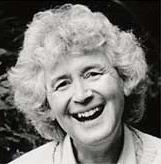 MTF transsexual Jan Morris (1926- ) (right) published her autobiography, Conondrum.73
MTF transsexual Jan Morris (1926- ) (right) published her autobiography, Conondrum.73
|
||
| 1975 | United States | Professional tennis champion Richard Raskind changed gender, and changed her name to Renee Richard. Later, the New Jersey State Supreme Court ruled that she can compete professionally in women's tennis tournaments.74 | ||
| 1979 | United States | The Harry Benjamin International Gender Dysphoria Association was organized to promote standards of care of transsexual and transgendered clients. In particular, they advocated the set of standards given in their publication, "The Harry Benjamin International Gender Dysphoria Association's Standards Of Care For Gender Identity Disorders, Sixth Version February, 2001." The first version is dated 1979. (Later versions were issued in 1980, 1981, 1990, 1998, and 2001.)75 | ||
| 1981 | United States | The AIDS epidemic officially began on June 5, 1981, when the U.S. Centers for Disease Control and Prevention (CDC) in its Morbidity and Mortality Weekly Report newsletter reported unusual clusters of Pneumocystis pneumonia (PCP) caused by a form of Pneumocystis carinii in five gay men in Los Angeles. (The name Acquired Immune Deficiency Syndrome (AIDS) for the disease was first suggested at a meeting of the CDC in July 1982. By August 1982, the name was generally accepted in the medical community.)76 | ||
| May 5, 1989 | San Clemente, California | Christine Jorgensen died from cancer of the lungs and bladder at the age of 62.77 | ||
| 1992 | Michigan | Nancy Jean Burkholder is expelled from the Michigan Wymen's Music Festival for being a transsexual.78 | ||
| 1993 | United States | Cheryl Chase founded the Intersex Society of North America (ISNA).79 | ||
| 1993 | Minnesota | An anti-discrimination law is passed in the State of Minnesota protecting transsexual and transgendered people along with Gays and Lesbians. This is a result of Trans, Gay, and Lesbian activists working together for many years. Minnesota is the first state to have such a law.80 | ||
| December 31, 1993 | Humboldt, Nebraska |
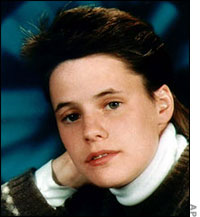 Trans man Brandon Teena (right), born as Teena Rae Brandon, was murdered by two men, John Lotter and Marvin Thomas Nissen, after they found out that he was biologically female. Brandon was 21 years old. Lisa Lambert, age 24, and Phillip DeVine, age 19, were killed with her. The true story of Brandon Teena is the basis of the screenplay for the movie, Boys Don't Cry, released in 1999.81
Trans man Brandon Teena (right), born as Teena Rae Brandon, was murdered by two men, John Lotter and Marvin Thomas Nissen, after they found out that he was biologically female. Brandon was 21 years old. Lisa Lambert, age 24, and Phillip DeVine, age 19, were killed with her. The true story of Brandon Teena is the basis of the screenplay for the movie, Boys Don't Cry, released in 1999.81
|
||
| 1994 | United States and Great Britain | The book Gender Outlaws: On Men, Women, and the Rest of Us by Kate Bornstein is first published.82 | ||
| August 7, 1995 | Washington, D.C. | Tyra Hunter, a 24 year old trans woman who had been badly injured in a hit-and-run car accident, died because of inadequate medical care after medical treatment was withheld by an Emergency Medical Service (EMS) technician at the scene of the accident. After the EMS technician had cut her pants off to treat one of her injuries, he had seen her penis and jumped back from her body. He is said to have shouted, "That ain't no bitch!" Treatment of Hunter's injuries stopped while other technicians gawked and ridiculed her. Finally, a supervisor was alerted by outraged and frightened bystanders who cried out "It don't make any difference, he's [sic] a human being!" The alerted supervisor then treated her. After being taken to the District of Columbia General Hospital, she was treated inadequately and died. On December 11, 1998 a jury awarded Hunter's mother, Margie, $2.8 million after finding the District of Columbia guilty of negligence and malpractice. Tyra had transitioned at the age of 14 and lived entirely as a woman. Over 2,000 people attended her funeral.83 | ||
|
October 4, 1995 The First National Gender Lobbying Day |
Washington, D.C. | The First National Gender Lobbying Day. A largely successful and very visible effort was made by over one hundred transgender activists to have each and every of the over five hundred office holders in the U.S. Senate and the U.S. House of Representatives lobbied. This was coordinated by Phyllis Randolph Frye (a Houston attorney and founder of the International Conference on Transgender Law and Employment Policy, Inc. (ICTLEP)). Kerry Lobel of the National Gay and Lesbian Task Force (NGLTF) and Nancy Buermeyer of the Human Rights Campaign gave practical lobbying pointers and encouragement to the other participating activists.84 | ||
| 1998 | Japan | The first legal sex reassignment surgery in Japan was performed. It was performed on a FTM transsexual.85 | ||
| 1999 | Japan | The first legal male to female sex reassignment surgery in Japan was performed.86 | ||
| 1999 | Texas | A Texas court ruled post-op transsexual Christie Littleton's eight-year marriage null and void, because she is assumed to have XY chromosomes, like her husband's, making the marriage against Texas' ban on same-sex marriages. The judge was quoted as saying "There is no cure for being male."87 | ||
| July 5, 1999 | Clarksville, Tennessee | U.S. Army Private First Class Barry Winchell was beaten to death with a baseball bat wielded by Private Calvin Glover. It happened a short time after 2:30 A.M. Winchell was sleeping when Glover began to bash his head in. He never woke up. Glover hated Winchell because Winchell's girl friend was a trans woman.88 | ||
| May 2000 | Lawson Wilkins Pediatric Endocrine Society | Cheryl Chase addressed the Lawson Wilkins Pediatric Endocrine Society following a landmark four-hour symposium on the treatment of ambiguous genitals in newborn infants. Her talk challenged the nearly universal practice of doing "corrective" surgery on infants born with ambiguous genitals so that the infants would physically fit into the male or female category. When previously in 1997 she had tried to present the viewpoint of intersex patients at a meeting of the American Academy of Pediatrics, the Academy refused to let her speak on the grounds that she and her supporters were "zealots."89 | ||
| 2002 | Boston, Massachusetts | The Boston City Council added gender identity and expression to the city's anti-discrimination law.90 | ||
| October 3, 2002 | Newark, California | Gwen Arajou, a 17 year old trans woman, was beaten and strangled to death by four young men after attending a party where the men discovered that she was transsexual. Michael Magidson, Jaron Nabors, Jose Merel, and Jason Cazares, buried her dead body at an isolated place in the foothills of the Sierra Nevada Mountains. Days later, after Gwen Arajou's mother reported Gwen missing since she had left for the party, Nabors led police to her grave in exchange for a plea bargain. He was later convicted of second-degree manslaughter. Later, Magidson and Merel were each convicted of second degree murder. The jury was deadlocked on Cazares. The jury did not consider the killing to be a hate crime, but rather a reaction to a sudden and shocking revelation. This was in accordance with what they were told by the prosecuting district attorney. The story of this murder was made into a Lifetime Television Network movie, A Girl Like Me: The Gwen Arajou Story, which premiered on June 19, 2006.91 | ||
| July 23, 2003 | Indianapolis, Indiana | Nireah Johnson, a 17 year old trans woman and her friend, 18-year-old Brandon Coleman, were both murdered by Paul Moore after Moore discovered that Johnson was biologically male. Moore shot both of them in the head. On May 5, 2004, Moore was given combined sentences of 120 years in prison for the murders of Johnson and Coleman. Moore's conviction and sentence were upheld on appeal in May 2005.92 | ||
| 2007 | United States | The book Whipping Girl: A Transsexual Woman on Sexism and the Scapegoating of Femininity by Julia Serano is first published.93 | ||
| March 2008 | United States | Accord Alliance, founded in 2007, opened its doors for the first time. Its main goal is to promote comprehensive and integrated approaches to care that enhance the health and well-being of people and families affected by sex development disorders (DSD, which includes some conditions referred to as "intersex"). The Intersex Society of North America (ISNA) shut down shortly afterwards as it was no longer needed.94 | ||
| July 17, 2008 | Greeley, Colorado | Angie Zapata, an 18 year old trans woman, was beaten to death by Allen Andrade after he learned that she was transgender. On April 22, 2009, Andrade was found guilty of first degree murder, hate crimes, aggravated motor vehicle theft and identity theft. He was sentenced to life in prison without the possibility of parole.95 | ||
| November 9, 2008 | Memphis, Tennessee | Trans woman Duanna Johnson was shot to death outdoors in a North Memphis street just before midnight. The assailants have never been identified. Johnson had filed a 1.3 million dollar law suit against the city of Memphis after being arrested in February 2008 for prostitution, handcuffed, taken to a police station, and beaten there the same day by Memphis Police officer Bridges McRae. Surveillance cameras recorded the beating. Bridges was later fired from the police department for beating Johnson.96 | ||
| November 14, 2008 | Syracuse, New Jersey | Lateisha Green (Moses "Teish" Cannon), a 22 year old transgender woman, was shot to death by Dwight DeLee because he thought she was gay. DeLee was convicted of first-degree manslaughter as a hate crime on July 17, 2009 and given the maximum sentence of 25 years in state prison.97 | ||
| October 28, 2009 | Washington, D.C. | President Barack Obama signed the Matthew Shepard and James Byrd, Jr. Hate Crimes Prevention Act into law. This is the first federal law to specifically protect transgender people, adding protections for gender, gender identity, disability and sexual orientation to the 1969 Hate Crime Act, which already covered race, color, religion and national origin.98 | ||
BIBLIOGRAPHY
Books
Califia, Pat. Sex Changes: The Politics of Transgenderism. San Francisco: Cleis Press, Inc., 1997. 309 pages. Paperback, ISBN-10: 1-57344-072-8.
Feinberg, Leslie. Transgender Warriors: Making History from Joan of Arc to Dennis Rodman. Boston: Beacon Press, 1996. 218 pages. Paperback, ISBN-10: 0-8070-7941-3.
Meyerowitz, Joanne. How Sex Changed: A History of Transsexuality in the United States Cambridge, Massachusetts: Harvard University Press, 2002. 363 pages. Paperback, ISBN-10: 0-674-01379-4; Hardback, ISBN-10: 0-674-00925-8.
Stryker, Susan. Transgender HistoryBerkely, California: Seal Press, 2008. 197 pages. Paperback, ISBN-10: 1-58005-224-X, ISBN-13: 978-1-58005-224-5.
On the Web
"20th Century Transsexual History and Experience" by Kay Brown (I highly recommend reading the entire contents of this site. Includes a timeline from 1907 to 1999.)
Wikipedia--"List of pre-Stonewall LGBT Actions in the United States"
Transgenderzone.com--"Transgender History" (A historical timeline beginning at 1479 BC.)
Transgender Tapestry - "The Transgender Rights Movement in the 21st Century" (column)- Issue posted May 2, 2003. (Includes a timeline, 1910-2002.)
PsychoanalysisArena.com--"Please Select Your Gender" by Patricia Gherovichi
Etransgender.com--"Transgender Revolution" by Dr. Robert T. Francoeur.
Gallae.com - "The Maetrium of Cybele" (Homepage of the Maetrium of Cybele, Magna Mater)
- Gallae.com - "We Are an Old People, We Are a New People, Part One" by Cathryn Platine.
FOOTNOTES
1The earliest ancient documentation of the transsexual priestesses of Innana found by modern archaeologists go back to the middle of the third millennium BCE (i.e., about 2500 BCE). But this fact may have more to do with the history of writing and record keeping than with the history of religion.
2 See Gallae.com - "We Are an Old People, We Are a New People, Part Two" by Cathryn Platine.
3See Wikipedia--"Joan of Arc", DistinguishedWomen.com--"Joan of Arc", and Leslie Feinberg, Transgender Warriors: Making History from Joan of Arc to Dennis Rodman (Boston: Beacon Press, 1996), pp. 34-37.
4 The quotation of John Martyr is from Wikipedia--"Balboa"--Wikipedia cites Daniel J. Boorstin, The Discoverers (New York: Random House, 1983), p. 257. Leslie Feinberg in his Transgender Warriors (1996), page 23 quotes Antonio de la Calancha, a Spanish official writing later in Lima: Balboa "saw men dressed like women; Balboa learned that they were sodomites and threw the king and forty others to be eaten by his dogs, a fine action of an honorable and Catholic Spaniard."--Feinberg gives as his source Francisco Guerra, The Pre-Colombian Mind (London: Seminar Press, 1971) 190, cited in Walter Williams, The Spirit and the Flesh: Sexual Diversity in American Indian Culture (Boston: Beacon Press, 1986), p. 137.
5Feinberg, op. cit., p. 22. Feinberg cites Pedro de Magalheis, The Histories of Brazil, trans. John B. Stetson, Jr. (New York: The Cortes Society, 1922), pp. 89-90.
6 Wikipedia--"Catalina de Erauso".
7Feinberg, op. cit., p. 23 -- Feinberg cites Jaques Marquette, Of the First Voyage Made by Father Marquette Toward Mexico, and How the Idea Thereof was Conceived, ed. Reuben Gold Thaits (Cleveland: Burrows, 1896-1901) 129, Vol. 59 of the Jesuit and Allied Documents, quoted by Jonathan Ned Katz, Gay American History: Lesbians and Gay Men in the U.S.A. (New York: Harper & Row, 1976), p. 287; see also Wikipedia--"Jaques Marquette" for details about Marquette's expedition.
8Wikipedia--"Mary Read"; Wikipedia--"Anne Bonny".
9Feinberg, op. cit., p. 23. Feinberg cites Joseph Francois Lafitau, Moeurs des sauvages amerquains, comparees aux moeurs des premiers tempts, 2 vols. (Paris: Saugrain, 1724) 1:52, pp. 603-10, quoted in Katz, op. cit., pp. 288-89.
10 Told in: NOVA Online--"Two Sexes Are Not Enough" by Anne Fausto-Sterling.; "Transgender Revolution" by Dr. Robert T. Francoeur.
11Feinberg, op. cit., p.25. Feinberg cites Walter Williams, The Spirit and the Flesh: Sexual Diversity in American Indian Culture (Boston: Beacon Press, 1986), p. 179.
12Wikipedia--"Magnus Hirschfeld".
13 Meyerowitz, Joanne, How Sex Changed: A History of Transsexuality in the United States (2002), pp. 18-19.
14 Dreger, Alice Domurat, Hermaphrodites and the Medical Invention of Sex (Cambridge, Massachusetts: Harvard University Press, 1998), pp. 158-59; Gherovici, Patricia, Please Select Your Gender: From the Invention of Hysteria to the Democratizing of Transgenderism (New York: Routledge, 2010), p. 31; Reis, Elizabeth, Bodies in Doubt: An American History of Intersex (Baltimore, Maryland: Johns Hopkins University Press, 2009), p. 99.
15Stryker, Susan, Transgender History (Berkeley, California: Seal Press, 2008), p.41.
16Meyerowitz, Joanne, How Sex Changed: A History of Transsexuality in the United States (Cambridge, Massachusetts: Harvard University Press, 2002), pp. 17-18.
17Wikipedia--"Magnus Hirschfeld".
18Feinberg, op. cit., p. 26. Feinberg cites Williams, The Spirit and the Flesh: Sexual Diversity in American Indian Culture (1986), p. 182.
19Stryker, op. cit., p. 41.
20Meyerowitz, op. cit., p. 19.
21Ibid., p. 19.
22Wikipedia--"Magnus Hirschfeld".
23Meyerowitz, op. cit., pp. 48-49; Wikipedia--"Laurence Michael Dillon".
26Meyerowitz, op. cit., p. 42.
27Jorgensen, Christine, Christine Jorgensen: A Personal Autobiography (San Francisco, California: Cleis Press, 1967), pp. 94-95.
28Jorgensen, op. cit., p. 106.
29Jorgensen, op. cit., p. 125.
30Jorgensen, op. cit., pp. 139-40.
31Meyerowitz, op. cit., p. 84.
32 Meyerowitz, op. cit., p. 103; Wikipedia--"Harry Benjamin".
33Meyerowitz, op. cit., p. 84.
34Jorgensen, op. cit., p. 235.
35Meyerowitz, op. cit., p. 85.
36Meyerowitz, op. cit., pp. 114-115.
37Meyerowitz, op. cit., pp. 146, 147; A Gender Variance Who's Who--"Georges Burou".
38Stryker, op. cit., pp. 59-61; Wikipedia--"List of pre-Stonewall LGBT Actions in the United States".
39Wikipedia--"Elliott Blackstone".
40Stryker, op. cit., p. 79; Wikipedia--"Reed Erickson"; A Gender Variance Who's Who--"Reed Erickson".
41Stryker, op. cit., pp. 79-80;Meyerowitz, op. cit., pp. 209-210;Wikipedia--"Reed Erickson"; A Gender Variance Who's Who--"Reed Erickson".
42Meyerowitz, op. cit., pp. 115-117.
43Wikipedia--"Masters and Johnson".
44Wikipedia--"List of pre-Stonewall LGBT Actions in the United States".
45Wikipedia--"List of pre-Stonewall LGBT Actions in the United States".
46Meyerowitz, op. cit., p. 118; Wikipedia--"Harry Benjamin".
47Wikipedia--"Masters and Johnson".
48Stryker, pp. 63-65; Wikipedia--"Compton's Cafeteria Riot".
49Stryker, op. cit., p. 75.
50Stryker, op. cit., p. 75.
51Meyerowitz, op. cit., p. 219.
52Meyerowitz, op. cit., pp. 230-31.
53Jorgensen, op. cit., p. i.
54Meyerowitz, op. cit., pp. 216-17.
55Meyerowitz, op. cit., p. 222.
56Meyerowitz, op. cit., p. 208.
57Meyerowitz, op. cit., pp. 236-37.
58Meyerowitz, op. cit., pp. 115-117.
59Wikipedia--"List of pre-Stonewall LGBT Actions in the United States".
60Meyerowitz, op. cit., pp. 223-24.
61Meyerowitz, op. cit., p. 216.
62Meyerowitz, op. cit., pp. 231-32. See also Stryker, op. cit., pp. 76-78, 81.
63Stryker, op. cit., pp. 83-85.
64Stryker, op. cit., p. 86.
65Meyerowitz, op. cit., pp. 224-25; Stryker, op. cit., p. 112; Vanderburgh, Reid, Transition and Beyond: Observations on Gender Identity (Portland, Oregon: Q Press, 2007) pp. 38-39.
66Wikipedia--"Masters and Johnson".
68Meyerowitz, op. cit., p. 259.
69Meyerowitz, op. cit., p. 257; Stryker, op. cit., pp. 92-93.
70 Georges Burou, M.D.--excerpt from PROCEEDINGS OF THE SECOND INTERDISCIPLINARY SYMPOSIUM ON GENDER DYSPHORIA SYMDROME--"Male to Female Transformation" by Georges Burou, M.D."; A Gender Variance Who's Who--"Georges Burou".
71Meyerowitz, op. cit., pp. 259-60.
72Stryker, op. cit., p. 93.
73Morris, Jan, Conundrum (New York: Harcourt Brace Johnavich, Inc., 1974).
74Wikipedia--"Renee Richards".
75Meyerowitz, op. cit., p. 255.
76Wikipedia--"AIDS"; Wikipedia--"Origin of Aids".
77Meyerowitz, op. cit., p. 282.
78Stryker, op. cit., p. 140.
79Stryker, op. cit., p. 138.
80"20th Century Transgender History and Experience" by Kay Brown.
81Stryker, op. cit., pp. 142-43; Wikipedia--"Brandon Teena"; tru Crime Library - "Teena Brandon".
82Bornstein, Kate. Gender Outlaw: On Men, Women, and the Rest of Us (New York: Vintage Books, 1995)
.83Wikipedia--"Tyra Hunter"; "from the Daily Kansan-Univerisity of Kansas at Lawrence - Editorial Page"; Transgriot Blogspot--"Tyra Hunter Anniversary", August 7, 2007;"It's Murder Out There" by Miranda Stevens-Miller.
84Califia, Pat Sex Changes: The Politics of Transgenderism (San Francisco: Cleis Press, Inc., 1997), pp. 222-23.
85The International Journal of Transgenderism--"Beginnings of Transsexual Surgery in Japan" by Takamatsu Ako (2001) et al.
86The International Journal of Transgenderism--"Beginnings of Transsexual Surgery in Japan" by Takamatsu Ako (2001) et al.
87"20th Century Transsexual History and Experience" by Kay Brown; Transgender Tapestry--"The Transgender Rights Movement in the 21st Century" by Li Anne W. Taft.
88New York Times, May 28, 2000--"An Incovenient Woman"; Addams, Calpernia Sarah, MARK 947 (Writers Club Press, 2002).
89Both events are reported in "Transgender Revolution" by Dr. Robert T. Francoeur.
90Transgender Tapestry--"The Transgender Rights Movement in the 21st Century" by Li Anne W. Taft.
91Stryker, op. cit., p. 143;Wikipedia--"Murder of Gwen Arajou".
92Wikipedia--"Nireah Johnson".
93Serano, Julia, Whipping Girl: A Transsexual Woman on Sexism and the Scapegoating of Femininity (Emeryville, California: Seal Press, 2007).
94Accord Alliance--"Welcome to Accord Alliance"; Wikipedia--"Intersex Society of North America".
96The New York Times November 17, 2008--"Murder of Transgender Woman Revives Scrutiny"; Eyewitness News December 29, 2008--"Homicide Victim Identified as Transgendered Person, Duanna Johnson".
97"The Story of Lateisha Green"; Transgender Legal Defense and Education Fund (TLDEF)--"Lateisha Green's Murder Classified as a Hate Crime".
98Wikipedia--"Matthew Shepard Act".
